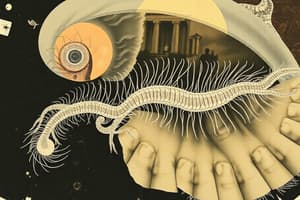Podcast
Questions and Answers
What is the study of the molecular, cellular, and structural factors contributing to the formation of an organism?
What is the study of the molecular, cellular, and structural factors contributing to the formation of an organism?
Embryology
What is the process called when one group of cells or tissues causes another set of cells or tissues to change their fate?
What is the process called when one group of cells or tissues causes another set of cells or tissues to change their fate?
- Mitosis
- Meiosis
- Induction (correct)
- Gametogenesis
Chromosomes inherited from the mother and father contain genes that determine the traits of a new individual. True or False?
Chromosomes inherited from the mother and father contain genes that determine the traits of a new individual. True or False?
True (A)
______ is the cell division in germ cells that generates male and female gametes.
______ is the cell division in germ cells that generates male and female gametes.
Match the following Chromosomal abnormalities with their description:
Match the following Chromosomal abnormalities with their description:
What is the role of Sertoli cells in the development of germ cells?
What is the role of Sertoli cells in the development of germ cells?
What stimulates the anterior pituitary to secrete FSH and LH?
What stimulates the anterior pituitary to secrete FSH and LH?
Abnormal spermatozoa are not as common as abnormal oocytes.
Abnormal spermatozoa are not as common as abnormal oocytes.
Spermiogenesis is the transformation of spermatids into __________.
Spermiogenesis is the transformation of spermatids into __________.
Match the following phases of spermiogenesis with their descriptions:
Match the following phases of spermiogenesis with their descriptions:
Flashcards are hidden until you start studying
Study Notes
Embryology and Development
- Embryology is the study of the formation and development of an organism from fertilization to birth.
- It is crucial for creating healthcare strategies, prenatal diagnoses, and treatments for infertility and birth defects.
History of Embryology
- The study of embryogenesis (organogenesis) focuses on the first 8 weeks of human development.
- The fetal period begins after the 8th week of development.
- Teratology is the study of the embryological origins and causes of birth defects.
Molecular Biology
- Induction and organ formation involve interactions between cells and tissues.
- Induction is a process where one group of cells or tissues causes another set of cells or tissues to change their fate.
- Competence is the capacity to respond to a signal, requiring activation of the responding tissue by a competence factor.
Cell Signaling
- Competency to respond to signals involves cross-talk between inducing and responding cells.
- Paracrine interactions involve diffusible proteins synthesized by one cell that interact with other cells.
- Juxtacrine interactions do not involve diffusible proteins.
Gametogenesis
- Gametogenesis produces gametes (sperm and oocytes).
- Spermatogenesis occurs in the seminiferous tubules of the testes and produces male gametes.
- Oogenesis occurs in the ovaries and produces female gametes.
Birth Defects and Spontaneous Abortions
- Chromosomal and genetic factors account for 50% of spontaneous abortions.
- 50% of abortuses have major chromosomal abnormalities.
- Chromosomal abnormalities account for 7% of major birth defects, while gene mutations account for an additional 8%.
Chromosomal Abnormalities
- Examples of chromosomal abnormalities include:
- Trisomy 21 (Down syndrome)
- Trisomy 18 (Edwards syndrome)
- Trisomy 13 (Patau syndrome)
- Klinefelter syndrome (XXY)
- Triple X syndrome (XXX)
Gene Mutations
- Many congenital malformations are inherited and show a clear Mendelian pattern of inheritance.
- Gene mutations can result in inborn errors of metabolism, such as phenylketonuria, homocystinuria, and galactosemia.
Diagnostic Techniques
- Techniques used to identify genetic abnormalities include:
- Cytogenetic analysis
- High-resolution metaphase banding techniques
- Fluorescence in situ hybridization (FISH)
- Chromosome painting
Oogenesis
- Maturation of oocytes begins before birth.
- At 5 months of prenatal development, there are approximately 7 million oogonia, which decrease to 600,000 to 800,000 at birth.
- At puberty, oocyte maturation continues, with 3 stages: primary, secondary, and preovulatory.
Spermatogenesis
- Maturation of sperm begins at puberty.
- Spermatogonia are transformed into spermatozoa, with 3 stages: spermatocytogenesis, meiosis, and spermiogenesis.
- Spermiogenesis takes approximately 74 days, and 300 million sperm cells are produced daily.
Hormonal Regulation
- The hypothalamus releases gonadotropin-releasing hormone (GnRH), which stimulates the anterior pituitary to release FSH and LH.
- FSH and LH regulate spermatogenesis and oogenesis.
Abnormal Gametes
- Abnormal gametes can result in birth defects or infertility.
- Abnormal spermatozoa are seen frequently, and up to 10% of all spermatozoa have observable defects.
Spermiogenesis
- Spermiogenesis is the transformation of spermatids into spermatozoa.
- It involves 4 stages: formation of the acrosome, condensation of the nucleus, formation of the neck, middle piece, and tail, and shedding of most of the cytoplasm.
Control of LH and FSH Secretion
- Negative feedback loops regulate LH and FSH secretion.
- Testosterone and inhibin inhibit LH and FSH secretion, respectively.
Oogenesis and Folliculogenesis
- Folliculogenesis involves the growth and development of follicles in the ovary.
- The antral follicle is the stage of folliculogenesis where the follicle has a fluid-filled antrum.
The Menstrual Cycle
- The menstrual cycle has 3 main phases: menstrual, proliferative, and secretory.
- The cycle is regulated by hormones, including estrogen and progesterone.
Studying That Suits You
Use AI to generate personalized quizzes and flashcards to suit your learning preferences.




